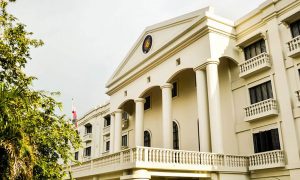UNDERSPENDING by government agencies could yet pose a drag on economic growth this year, analysts said.
“I certainly think that underspending is a big risk, given that we’ve yet to see any meaningful consolidation of the government budget — in nominal terms — since the deficit blew out during the pandemic,” Pantheon Macroeconomics Chief Emerging Asia Economist Miguel Chanco said in an e-mail.
“But this is likely also a reflection of the slowdown in growth, which will affect government revenue and, in turn, constrain the ability of the government to spend.”
On the sidelines of an event last week, Budget Secretary Amenah F. Pangandaman said that government agencies’ overall disbursement and obligation rate as of the end of the first quarter was 45.6%.
When asked about the risk of underspending this year, Ms. Pangandaman told reporters: “There is still (a risk,) because (government agencies) still have issues in procurement.”
Obligation refers to a government agency’s payables for projects which are due in the near to medium term. On the other hand, disbursements are the actual cash withdrawals from the Treasury to fund liabilities from its programs or projects.
The government seeks to ensure timely spending of funds to keep up the momentum for gross domestic product (GDP) growth.
The Department of Budget and Management (DBM) has asked all underspending agencies to submit their “catch-up plans” to address low budget utilization and issues with project or program implementation.
Quarterly, it also assesses government agencies’ spending performance especially for big-ticket items.
“The DBM conducts periodic agency performance reviews to assess both physical and financial performance, identify strengths and areas for improvement, and provide necessary support to keep projects on track,” Budget Undersecretary Goddes Hope O. Libiran said via Viber.
Government agencies and offices were also reminded to procure in a timely manner to ensure projects are bid out on time.
Early procurement is also a feature of the proposed New Government Procurement Reform Act, which is awaiting the President’s signature.
“These communications keep agencies on track with their reporting obligations and emphasize the importance of adhering to budgetary schedules,” Ms. Libiran said.
Last year, fiscal underspending was cited as one of the reasons for the 4.3% GDP growth posted in the second quarter, the weakest in two years.
To improve state spending, legislators must reduce “patronage-driven” insertions in agency budgets, according to Institute for Leadership, Empowerment, and Democracy, Inc. public budget analyst Zy-za Nadine M. Suzara.
“These insertions cause delays in procurement and implementation, and thus (represent) underspending on the part of the agencies,” she said via Viber. “How can early procurement be done if the projects are inserted right before the budget is passed?”
Government agencies and offices must also bolster planning and budgeting linkages across the bureaucracy, Ms. Suzara added.
Terry L. Ridon, a public investment analyst and convener of think tank InfraWatch PH, said the benchmark for monitoring state spending is too low.
“The 25% (overall obligation and utilization rate per quarter) is such an unrealistic and low benchmark which allows poor performers to justify their failure in efficiently using state resources,” he said via Viber.
“Timely spending is most crucial in the building of capital resources such as buildings and other infrastructure because the sooner roads and bridges are built, the sooner can economic activity in various areas scale towards unprecedented levels,” Mr. Ridon noted. — Beatriz Marie D. Cruz
